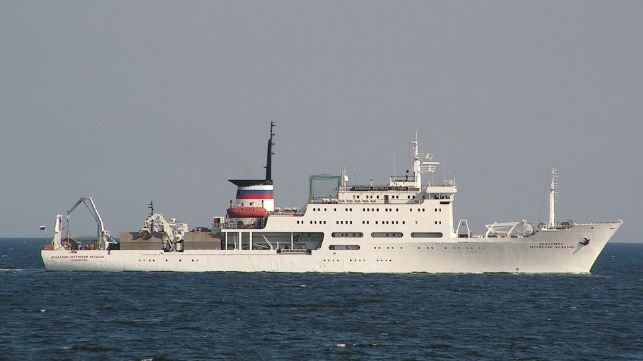Russian Researchers Find Widespread Methane Seeps Across Laptev Sea

An international team of oceanographers aboard the Russian research vessel Akademik Keldysh has confirmed a large-scale, ongoing release of methane from the seabed on the East Siberian Arctic Shelf.
At six locations along an 80 nautical mile trackline in the Laptev Sea, the researchers observed methane bubbles rising in clouds from the bottom, they told The Guardian. At one location, they found methane concentrations in the water exceeding normal levels by a factor of 400.
The gas is believed to be released by the melting of subsea permafrost, which in turn allows the release of methane gas from previously-stable methane hydrates. The seabed of the East Siberian Arctic Shelf is unique in that large swaths contain permafrost layers built up some 20-30,000 years ago, when the area was dry land and sea levels were far lower.
Diverse samples/data secured. Two key findings: bubbles+methane released from slope (hydrates?) and shelf sunk-in craters. #scienceresearch #scienceoutreach #science #instaresearch #oceanography #climatechange #climate #greenhousegasses #explore #arctic #permafrost pic.twitter.com/Do99dylVDZ
— International Siberian Shelf Study Expedition 2020 (@ISSSarctic2020) October 22, 2020
"The discovery of actively releasing shelf slope hydrates is very important and unknown until now,” chief scientist Igor Semiletov told the paper. “Potentially they can have serious climate consequences, but we need more study before we can confirm that.”
Their results have not yet been peer-reviewed or published, but they represent an extension of previous observations of methane seeps in the same area. In voyages to the region in years past, Semiletov's team has discovered large craters on the seabed emitting significant quantities of methane.
In an independent voyage in 2014, a team led by Brett Thornton of Stockholm University found that methane emissions from the ocean into the atmosphere in the Laptev Sea were averaging about 4.5 milligrams per square meter per day. In a study published earlier this year in Science Advances, the team estimated the methane release rate for the entire ESAS at about 4.7 million tonnes per year - the greenhouse gas equivalent of the combustion of about 270 million barrels of oil.
Signs of warming in the high Arctic are unmistakable, and not just on the seabed. This year, the Arctic summer sea ice extent fell to the second-lowest level on record, opening new possibilities for navigation. Taking advantage of the favorable conditions, a Russian tall ship made a voyage through Russia's Northern Sea Route - including the Laptev Sea - for the first time in 150 years. Its crew encountered virtually no ice. In October, sea trials for Russia's newest nuclear icebreaker had to be postponed because her crew could not find any ice thick enough to break.
